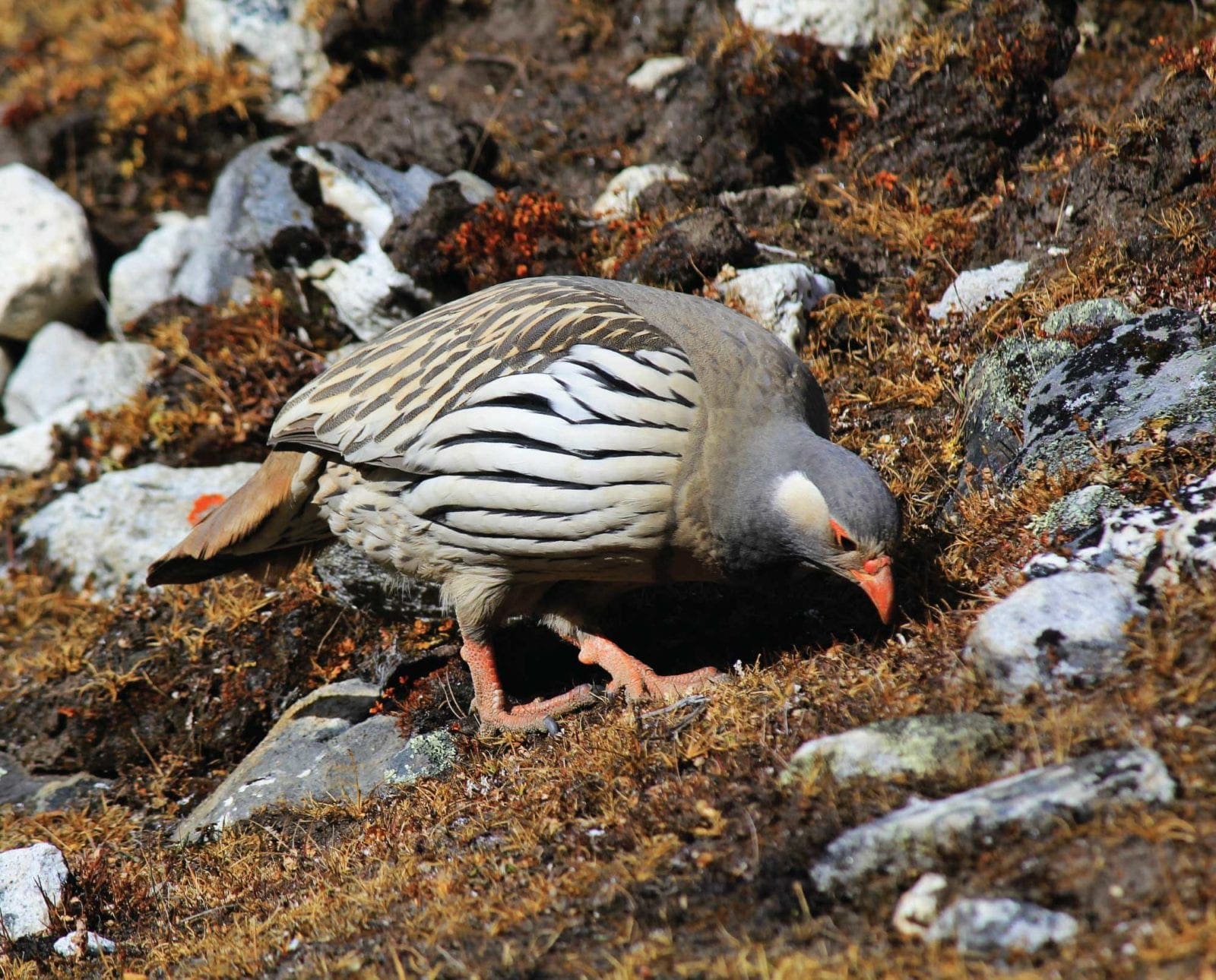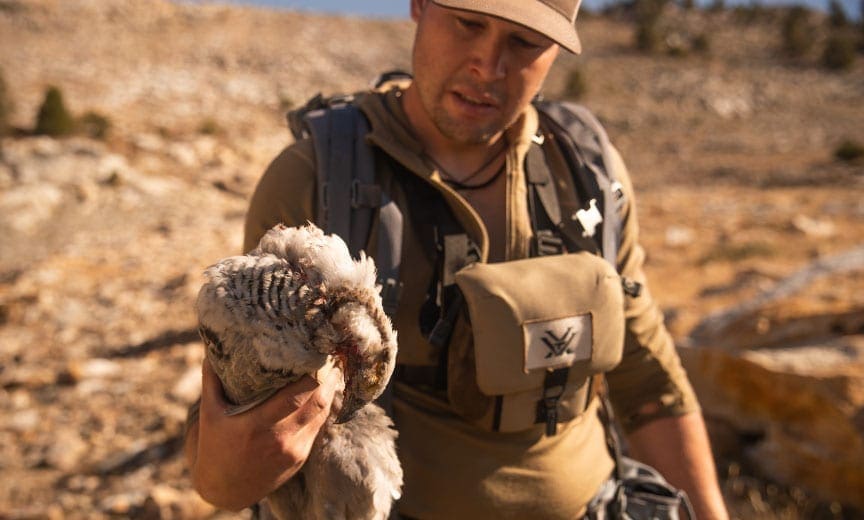Home » Himalayan Snowcock Hunting » Himalayan Snowcock (Tetraogallus himalayensis) – A Non-Native Game Bird
Himalayan Snowcock (Tetraogallus himalayensis) – A Non-Native Game Bird

Ryan Lisson is a biologist and regular content contributor to…
The Mysterious Mountain Bird from the Himalayas replanted in the Ruby Mountains of Nevada known as a snowcock
There aren’t many birds that can stand up to the rough conditions that high alpine meadows and mountain slopes offer, but the Himalayan snowcock (Tetraogallus himalayensis) is a champion among them. These tenacious birds were introduced to the mountains of northeast Nevada in 1963 from their native range in the Himalayan Mountains (The Cornell Lab of Ornithology, 2018). However, the population wasn’t fully established until the 1980s. Like another introduced bird, the chukar, the snowcock is more than capable of thriving in areas where most hunters and birders are reluctant to venture. Read on to learn more about this fascinating exotic game bird.
Description and life history of the Himalayan Snowcock
The Himalayan Snowcock is an unusual and pretty bird. They are quite large for game birds, weighing between 4 and 7 pounds and measuring about 22 to 29 inches in length (Nevada Department of Wildlife, 2018). Their feathers are generally gray, white, and tan. The wings have white and gray stripes running along them and their heads have white and chestnut-tan stripes or blotches. The back and tail feathers tend towards brown. Its bill can be dark gray in color, but their legs vary from light pink to orange-yellow. Males and females look similar with the exception that males are larger (ibid).
Himalayan snowcock nests consist of a simple depression scraped into the ground (National Audubon Society, 2018). The nest site should be sheltered from the wind by some kind of structure like bunches of grass or rocks. On average, females lay four to six buff or gray eggs spotted with rust colored dots. The female then incubates them for about four weeks until they hatch. Although the chicks are precocial (they can immediately leave the nest to find their own food), they are tended by both the male and female for a few more weeks (ibid). Family groups may stick together throughout the fall hunting season and some of the winter.
These small groups of Himalayan snowcock often feed together throughout the day and slowly move upslope as they forage on roots, tubers, and seeds (ibid). At the end of the day, the birds often take flight and glide downslope to a safe place to roost for the night. Alternatively, they may cross over to the base of a neighboring ridge to start their foraging again.
Because of their remote and rugged habitat preferences, there are very few predators for the snowcock besides humans. Raptors, golden eagles, and some small predators like foxes may be the only natural predators they have. More research is likely needed on the species in America.
Range and habitat of the Himalayan Snowcock
As mentioned, the Himalayan Snowcock is originally native to the Himalayan Mountains in Asia. Most likely due to their very specific altitudinal habitat requirements, the species hasn’t really spread in North America like other exotic species have. They are still known to occur in Nevada’s Ruby Mountains where they were introduced and the East Humboldt Range in North America (ibid).
The best habitat for the Himalayan snowcock consists of high alpine meadows above the tree line where they can forage and raise their chicks. Typically, these meadows are located at elevations between 9,000 and 11,000 feet, though the birds can be found up to 16,000 feet. This means they are surrounded by rugged mountains, steep slopes, and drop-off cliffs (The Cornell Lab of Ornithology, 2018). They utilize grassy cliff ledges in very steep areas. The rough topography and high elevations make these birds difficult to get to—let alone hunt.
Conservation issues for the Himalayan Snowcock
The global breeding population for the Himalayan Snowcock is very stable. However, they do not exist in large numbers in North America. It’s estimated that only a few hundred birds exist in Nevada. Yet because they have persisted for a few decades and are so tough to hunt, there are no real conservation issues associated with the species.
Hunting opportunities for the Himalayan Snowcock
If you think chukar hunting is hard, you might want to practice a bit more before you attempt to hunt the Himalayan snowcock. The rugged and inaccessible environment is tough to navigate and these birds have an annoying habit of spooking well before you get close. They often make high pitched whistling sounds. Listen for them as you hike along. Pay attention to the direction they came from. You’re more likely to hear the birds before you see them.

As mentioned above, they are only found in Nevada—specifically Elko and White Pine county. Prior to hunting Himalayan Snowcock, you need to get a snowcock hunting free-use permit, which is available online at www.ndowlicensing.com.
| State | Season | Season/Possession Limit |
| Nevada | September 1-November 30 | 2 birds |
Hunting these amazing birds is certainly a test of your physical strength and endurance. It will also test your mental willpower. After hiking all the way above the tree line to get to the elevations where this species lives, you still may or may not be able to hunt one. Getting close enough to shoot at one might be even harder given the lack of cover available. But if you can make a plan come together, you will find yourself among a very elite group of people who can make such a claim. And that’s a pretty awesome achievement.
Sources:
The Cornell Lab of Ornithology. 2018. Birds of North America. Accessed at: https://birdsna.org/Species-Account/bna/species/himsno/introduction
National Audubon Society. 2018. Guide to North American Birds. Accessed at: https://www.audubon.org/field-guide/bird/himalayan-snowcock
Nevada Department of Wildlife. 2018. Nevada Small Game Hunting Guide. 2018-2019. Accessed at: http://www.eregulations.com/wp-content/uploads/2018/08/18NVSG.pdf
Ryan Lisson is a biologist and regular content contributor to several outdoor manufacturers, hunting shows, publications, and blogs. He is an avid small game, turkey, and whitetail hunter from northern Minnesota and loves managing habitat almost as much as hunting. Ryan is also passionate about helping other adults experience the outdoors for their first time, which spurred him to launch Zero to Hunt, a website devoted to mentoring new hunters.





Congrats on your hunt.. A few things left off of the descriptions and habits– the lichen and moss on the north aspects of the rubies is also a main source of food – especially during the snow covered times. Ad generally, the north aspects of slopes and ridges hold the birds more than the other directions. And there have been birds sighted all the way to harrison pass to the south, and an individual bird was found dead on the ruby marsh road back in the late 90s, which i mounted for NDOW Elko office with a very juvenile golden eagle chasing it.
Can we do farming of this bird in close environment in Himalayan region?